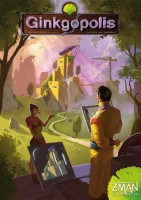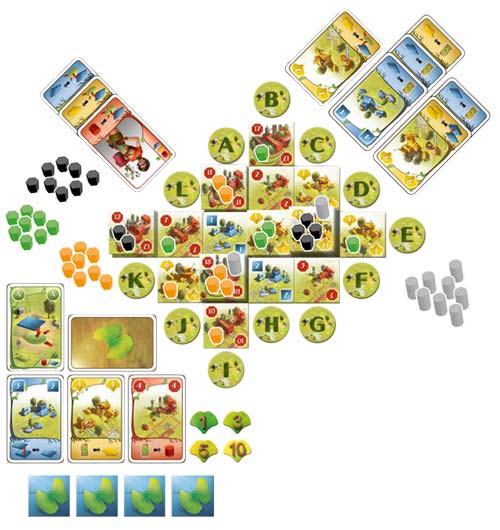
Ginkgopolis
1-5
13+
45
2212. Ginkgo Biloba, the oldest and strongest tree in the world, has become the symbol of a new method forbuilding cities in symbiosis with nature. Humans have exhausted the resources that the Earth offered them, and humanity must now develop cities that maintain a delicate balance between resource production and consumption.
However, habitable space is scarce, and mankind must now face the challenge of building ever upwards. To develop this new type of city, you will gather a team of experts around you, and try to become the best urban planner for Ginkgopolis.

images © Z-Man Games
User Reviews (2)
Add a Review for "Ginkgopolis"
You must be logged in to add a review.

In Brief: Ginkgopolis is a well-designed and attractive strategy game in which you compete to get the most success points from optimal construction of buildings as an urban planner in a future eco-friendly city. Simultaneously play means it stays around 1 hour to play with 4 players. Works with 1 to 5 players and various initial conditions so there is variety for repeated play. The theme is questionable (could just as easily have not had anything to do with the Ginkgo Biloba tree) and a few parts are confusing, but overall a great addition to the game library!
In Detail: Setup.The game revolves around three primary elements each with associated color in cards and building tiles: red resources, blue buildings, and yellow success points. There are 20 numbered building tiles (#1-20) in each of these 3 colors (60 total) and a corresponding building card for each. The game starts with a 3×3 grid of randomly placed tiles numbered #1-3 in each color, and 12 urbanization tokens labeled A-L are placed on the perimeter. Each player chooses a colored screen for hiding their pieces and associated resources in their player color. You start out by drafting 3 character cards that give you resources, building tiles, and points to start the game. For your first game, best to assign these by random number (1-6). Both character cards and later on, building cards that you control are placed in front of the player screen for all to see the benefits they provide. The starting deck of shuffled cards contains a card for each of the initial 9 buildings and one for each of the 12 urbanization letter-tokens. A starting player is chosen with associated labeled card and each player is given 4 cards from the deck.
Game play.All players choose 1 of the 4 cards from their hand to play and place it face down in front of their screen. Depending on the card, they may also need to place a building tile face down with their card. When everyone is ready, the first player reveals their card (and optional building tile) completes their action and each player does the same in clockwise order. After all have played, pass your 3-card hand of cards to next person as well as the starting player card, and draw back up to 4 cards from the deck. Continue until end game condition is met.
There are three types of actions to take corresponding to the two types of cards (buildings and urbanization) and whether you have a building tile with it. The first is “Exploiting” or just playing a card. If the card is a building, you get a number of element(s) equal to the height of the building and type corresponding to the color (red=resources, blue=building tiles, yellow=points). If it’s an urbanization card, you get either a single resource or building tile. The second action is “Urbanization” where you place a building tile with an urbanization card. Place the tile where the letter is, thereby expanding the city outward. Place a resource from your hidden supply on the building tile along with a new-construction marker and move the letter next to your new tile. Your reward for building is to receive all bonuses of buildings adjacent to your new tile as if you Exploited each of them (e.g. a point if next to a 1-story yellow building, 3 building tiles if next to a 3-story blue building, etc.). Lastly, the third action is “Construction” where you play a building tile on top of a current building matching the card you played. When done, you must put the number of resources on top of it equal to its height (always 2+), add a construction marker, and pay any costs if your new tile is a lower number than what it replaces (1 point per difference) and a resource if it’s a different color. If you place on top of someone else’s building, they get their resources back and points equal in number. Your reward for building is to keep the building card you replaced in front of you along with your character cards.
After playing your action, you then take any bonuses given to you with that action by the cards in front of you. So this means that players who have lots of bonuses for taking the Exploiting action, may do that more often to get these rewards. Building cards with higher numbers provide a variety of end-game bonuses (e.g. 1 point for each blue building you control, etc.).
When the deck of cards runs out, you take the discard pile and add building cards to it corresponding to each building with a new construction marker. When done, remove the construction markers. This means that all cards in the deck correspond to A-L tokens or buildings that are visible (on top) on the table. When the pile of building tiles runs out, there is a one-time restocking by players who get a point for each tile they donate back.
Game end & final score. The game ends when either the building tiles run out twice or a player has placed all of their resources on the board. The score is the sum of success point tokens plus bonuses provided by building cards. Then there is an additional score given to the first and second place controller of each district, a group (2+) of buildings adjacent with the same color.
Personal take: First, the theme really doesn’t make sense to me. This is a strategic city-building game and success points in the form of yellow and green ginkgo biloba leaves could just as easily be victory points or liquid capital ($). The more efficient your building is, the more you save and better the city. The theme could just as easily been 1800s Industrial Age or Ancient Rome or Current city planning or even bacteria growth in a petri dish grid!
Once you’re over the theme, the game itself is great! It takes a full game to understand play and develop strategies especially with the importance of end-game scoring. It plays well with 1-5 players, with the solitaire playing a 2nd game ‘bot that is always building on top of other buildings. Adding more players slows play down a little as each takes their action in turn, although they all think about it at the same time. The pieces are gorgeous and have tremendous amount of details, although most of the card symbols do require referencing the rules. Recommended!
I had seen Ginkgopolis being played quite often. It seems to be the game du jour. I was a little wary of learning the game because it seemed pretty complex and intricate. I couldn’t have been more wrong. The game was explained very easily in 5-10 minutes and after just one or two turns, I absolutely got the game.
After that I had so much fun playing it (the number one bonus with any game for me). I felt like I was really into it with the other plays and I was fully participating. Unlike some other new games I’ve played, this felt like we were actually playing together instead of just next to each other.
The game itself is incredibly well designed as well. Great looking art on the tiles. Wooden pieces (always a plus). Lots of color. Simple design in gameplay by matching colors and numbers.
Towards the end of the game, I finally started to realize what some of my strategy should be to try and win. However, by that point I didn’t care. I was just having fun. I’m sure with future plays I’ll focus on deeper strategy. But that was what I also liked about the game. It was super easy to learn and fun to play, but I could also see a lot of deeper strategy as you get into it.
Overall, this is the first new game that I’ve learned in a while that I can’t wait to try again.